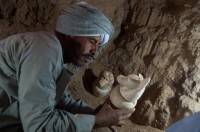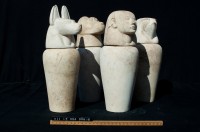 Italian archaeologists excavating the mortuary temple of 18th Dynasty (1550-1291 B.C.) pharaoh Amenhotep II in Luxor have discovered a number of rock tombs from the Third Intermediate Period (1075 – 664 B.C.). Each tomb has been cut into the rock with a deep shaft leading down into a burial chamber. The burial chambers contain the remains of wooden sarcophagi painted in black and red with funerary and religious scenes, skeletal remains, canopic jars and furniture for use in the afterlife.
Italian archaeologists excavating the mortuary temple of 18th Dynasty (1550-1291 B.C.) pharaoh Amenhotep II in Luxor have discovered a number of rock tombs from the Third Intermediate Period (1075 – 664 B.C.). Each tomb has been cut into the rock with a deep shaft leading down into a burial chamber. The burial chambers contain the remains of wooden sarcophagi painted in black and red with funerary and religious scenes, skeletal remains, canopic jars and furniture for use in the afterlife.
The canopic jars are of excellent quality. There are 12 in total, some in limestone, the others in burnt clay. These vessels were used to hold the liver, lungs, stomach and intestines of the dead. The lids of the jars are carved in the shape of the four sons of Horus who are charged with protecting the organs. The baboon-headed deity is Hapi, guardian of the lungs. The human headed deity is Imsety; he protects the liver. Qebehsenuef has a falcon’s head and guards the intestines. Duamutef’s jackal head protects the stomach.
The canopy [sic] vases are thought to have come from the tomb of a woman. They date back to the period between 1075 and 664 B.C. and, [lead archaeologist Dr. Angelo] Sesana notes, were laid out in the manner of two on one side and two on the other of the burial, inside of which a sarcophagus and skeleton were found. The archaeologist said that they were unidentified. “But another time, and it was such a strong emotion that I began jumping up and down, I found canopy vases with the inscription of the name of the dead. It was the same name as that of a sarcophagus I had identified six years before.”
 The contents of the tomb have been moved to a Luxor storehouse for restoration and examination. When the conservation and research is done, they’ll be put on display in a museum.
The contents of the tomb have been moved to a Luxor storehouse for restoration and examination. When the conservation and research is done, they’ll be put on display in a museum.
Other finds made this season include a monumental ramp and the tomb of a child of around six months of age. The body was missing, but inside the terracotta sarcophagus were artifacts — a beautiful set of bowls, plates and assorted tableware — neatly laid around a space where a mummy once was. The sarcophagus lid was broken, probably by looters in antiquity. The child’s tomb dates to the Middle Kingdom, around 1800 B.C., and archaeologists believe there may be a connection between it and the tombs of two young women from the same period discovered in last year’s dig.
The quality of the artifacts suggests the tombs hold the remains of élite members of Third Intermediate society. The fact that rich and important people were being buried in Amenhotep II’s temple at least four centuries after his death (he reigned from approximately 1427 to 1401 B.C.) underscores the religious importance of the temple even after its builder’s dynasty was long gone.
The Italian archaeological team from the Center of Egyptology Francesco Ballerini (CEFB) has been excavating the temple of Amenhotep II for fifteen years. For more about the temple and the group’s excavations, see their website. It has an interesting excavation diary but that’s only available in Italian. It’s worth firing up an online translator to read it, though.